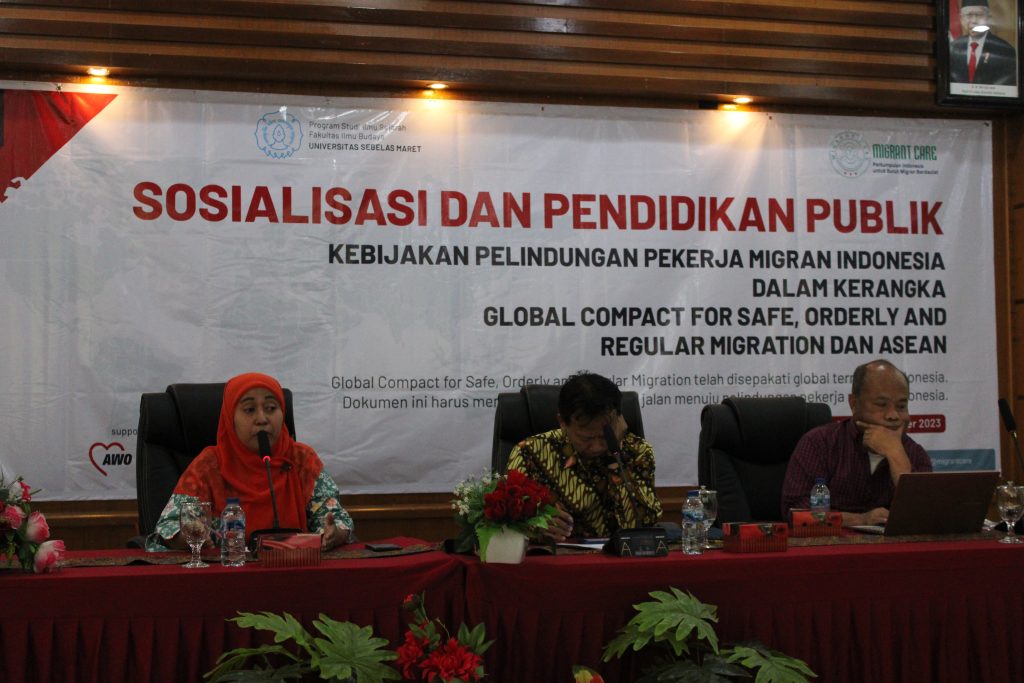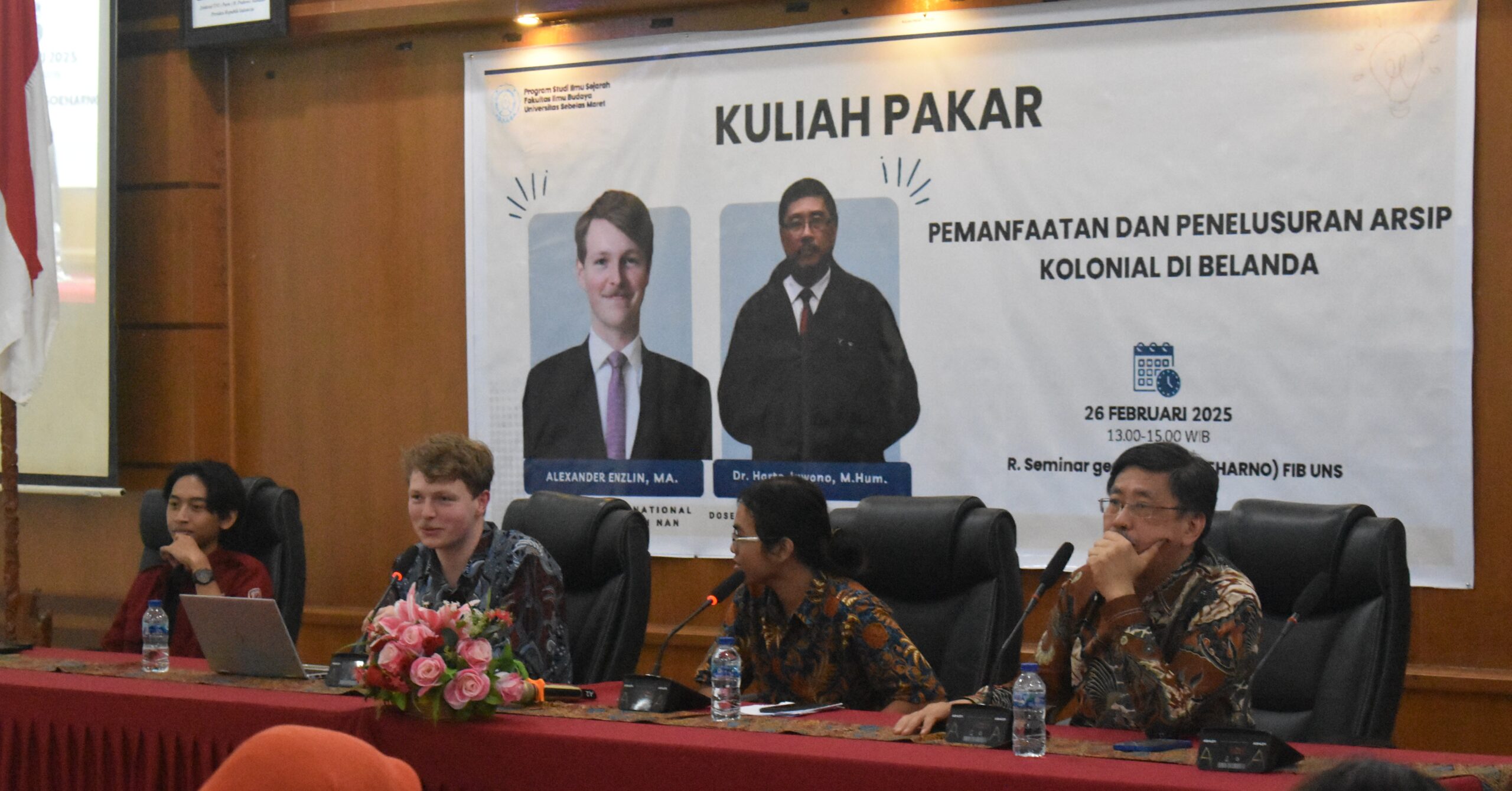 Beginning with the complex problems of migrant workers, students are invited to research in greater depth various matters to be expressed in a research forum, the History Study Program, Faculty of Cultural Sciences (FIB) Universitas Sebelas Maret (UNS), in partnership with Migrant CARE and the Faculty of Social and Political Sciences (FISIP) UNS held a seminar entitled “Sosialisasi dan Pendidikan Publik Kebijakan Pelindungan Pekerja Migran Indonesia dalam Kerangka Global Compact for Safe, Orderly and Regular Migration dan ASEAN” [Socialization and Public Education of Policies for the Protection of Indonesian Migrant Workers within the Framework of the Global Compact for Safe, Orderly and Regular Migration and ASEAN].
Beginning with the complex problems of migrant workers, students are invited to research in greater depth various matters to be expressed in a research forum, the History Study Program, Faculty of Cultural Sciences (FIB) Universitas Sebelas Maret (UNS), in partnership with Migrant CARE and the Faculty of Social and Political Sciences (FISIP) UNS held a seminar entitled “Sosialisasi dan Pendidikan Publik Kebijakan Pelindungan Pekerja Migran Indonesia dalam Kerangka Global Compact for Safe, Orderly and Regular Migration dan ASEAN” [Socialization and Public Education of Policies for the Protection of Indonesian Migrant Workers within the Framework of the Global Compact for Safe, Orderly and Regular Migration and ASEAN].
This activity was held on Thursday morning (12/10/2023) in the Meeting Room of Building I. Suharno FIB UNS and broadcast live via the Zoom application. Discussion moderated by Plt. Head of the FIB UNS History Study Program, Dr. Waskito Widi Wardojo, S.S., M.A. This invited Aris Arif Mundayat Ph.D. (Lecturer in Sociology Study Program, FISIP UNS), Insiwi Febriary Setiasih, S.S., M.A. (Lecturer at the FIB UNS History Study Program) and Wahyu Susilo, S.S., M.A. (Executive Director of Migrant CARE) as resource person.
Mulyadi, as the Migrant CARE Management Board, invited the participants consisting of FIB UNS History Study Program Students (fifth semester) and FISIP UNS Sociology Study Program Students (fifth and seventh semesters) to have a more in-depth discussion about migrant workers. “You (participants) can make migrant workers the object of study, therefore we are conducting outreach for academics so that all our friends can raise the issue of migrant workers in ASEAN, especially in a work,” he explained.
Plt. Deputy Dean for Academic, Research and Student Affairs FIB UNS, Prof. Dr. Tri Wiratno, M.A., through his speech invited students to raise the issue of migrant workers in their thesis or thesis. “I want to tell you briefly about migrant workers, at that time I was invited as a guest lecturer at Hong Kong Polytechnic University to meet several migrant workers there, they told me many things about joy and even sadness. “Well, in Hong Kong, there is a publication where foreign workers can voice their complaints. This incident shows that there are interesting topics to research as a bachelor’s or master’s thesis,” he noted.
Aris opened the presentation session and addressed the Global Compact for security, order, and regular migration. “The principles of the Global Compact for Migration (GCM) include the protection of human rights, the promotion of non-discrimination, and recognition of the complex nature of migration as a global phenomenon that requires collaborative efforts between governments,” he added.
In her presentation, Insiwi discussed migrant workers from a historical perspective, presenting her material entitled Migrasi Orang-orang Indonesia dalam Arus Sejarah [Migration of Indonesian People in the Flow of History], which documented the history of Indonesian people were sent to foreign countries as workers. Wahyu, the final speaker and a FIB UNS History Study Program alumnus, discussed about the Future of Migrant Workers in the ASEAN Region.
“A closer analysis reveals that migrant workers in ASEAN contribute considerably to growth but have not received recognition and protection”. Economic growth in the ASEAN area is washed by the sweat of migrant workers in infrastructure, plantations, fisheries, services, maintenance, and other sectors, as Wahyu mentioned in his presentation.
Wahyu further stated that international human rights institutions are still exceptionally limited in developing policies to protect migrant workers. The solution is to increase global commitment in ASEAN. “This global commitment can be a foundation or foothold for consolidating and energizing ASEAN’s modalities regarding migrant workers by compiling an ASEAN Roadmap regarding the protection of migrant workers as an inseparable part”, he added.
The attendees’ enthusiasm reverberated in the question-and-answer session, and the concluding session consisted of group photos. This practice is one of the faculty’s ways of helping students have a better understanding of migrant workers. It is intended that students will be inspired to create work that may be used as a tool, allowing the migrant worker movement to become more solidly established as part of the social movement for global justice.


